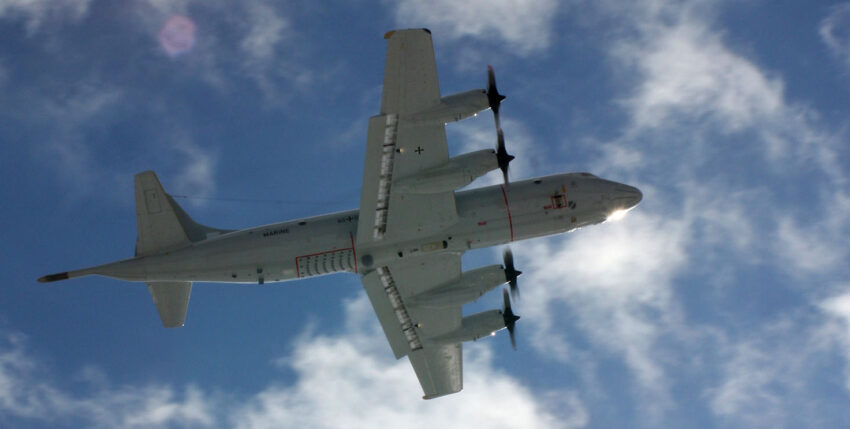Excerpts from the "Preliminary conceptual guidelines for the future capability profile of the Bundeswehr", which is to be adopted vis-à-vis NATO by 2032 (F.A.Z. PLUS article "Up to the stars" from 18 April). It is a non-binding declaration of intent; nonetheless, it leads to - justified - expectations within the Alliance. Among other things, the following can be heard for the navy's contribution (our emphasis): "Simultaneous provision of at least 15 floating platforms including support units across all "Maritime Warfare Areas" (three-dimensional naval warfare) and additionally two maritime reconnaissance aircraft for a Naval Task Force with maximum/high response capability. ... Capability to fight in the entire intensity spectrum, continuation of the capability for three-dimensional naval warfare with the extension to the use of cyber and space and the restoration of the capability to conduct naval warfare from the air."
It was a dark day for the naval aviators when the remaining Tornado squadron was transferred to the Luftwaffe with the proviso that the "naval warfare from the air" capability was to be maintained. Even then, it was clear that the maritime dimension would not be one of the Luftwaffe's priorities. It is now time to clearly derive the requirement to "restore the ability to conduct naval warfare from the air". To avoid awakening any false desires: This is not about bringing a Tornado squadron back into the navy. The train has left the station - also in view of the limited service life of the aircraft type. It is unlikely that a manned combat aircraft will be considered for the required capability. Let's focus more on the sea and land target armament of maritime patrol aircraft and future unmanned systems.
There are two components to consider with regard to maritime patrol aircraft: Firstly, the capability of the Orion P3; secondly, the question of whether Germany, as the "MPA lead nation" in Europe, needs to take the next step. It is obvious that the German Navy's Orion P3 can carry missiles and torpedoes. At this point, the question of future armament arises against the background of the new Northern European industrial constellation in connection with the German-Norwegian submarine co-operation. We are thinking of an industrial quadrangle consisting of Diehl Defence, Atlas Elektronik, Kongsberg and Saab. Atlas is working with Kongsberg on the command and control system for the U212 NG submarines. Berlin has declared that the multi-purpose combat ship MKS 180 the next generation of the Norwegian Joint Strike Missile. On the basis of the RSB 15 - mounted on the K 130 corvette - Saab has been commissioned by the Swedish government to develop the next generation of air- and sea-launched JSMs. The industrial partner is Diehl Defence. We have mentioned Atlas Elektronik in this context because the "aerial torpedo" weapon must also be taken into account.
The argument is that the American Harpoon system must be considered. However, the politically motivated Nordic cooperation described above speaks a different language. Norway and the UK are procuring the next generation MPA: Poseidon P8 from Boeing. As the European lead nation, shouldn't Germany also take the next step? Of course, the European top dog Airbus will offer MPA capability. It also needs to be clarified whether the Orion P3 - properly armed! - should be kept in service until a technologically realistic migration to unmanned armed systems is imminent. As a European leaning power that is arming partners, especially in the Baltic Sea region, Berlin must also make the new/old capability of naval warfare from the air accessible to its allies. Much remains to be done conceptually!











15 responses
The money that has already been spent on both the airframe and avionics of the P-3C is wasted if the old mills don't fly as long as the Sea Kings and it would also become a case for the Court of Auditors. They will still hang sub-hunting torpedoes in the Weapons Bay, yes. But to be able to credibly assert territorial claims (Baltic Sea) or counter symmetrical threats in a timely (!) manner, a jet squadron is absolutely essential. At this early stage, however, it would be pointless to think about the type, whether manned or unmanned. However, it would not be pointless to keep the Hohn airfield open - ideal location!
Point 1: It is not about the Baltic Sea. Here, both NATO and the EU have gained new partners that facilitate the task of ASW in the Baltic Sea. So we really don't need jetties for this regional area. Times are changing...
Point 2: the submarine threat in the North Atlantic, the Norwegian Sea and the Barents Sea is growing again. This is why the UK has reversed its own decision to abolish the MPA and is buying a US solution because it can be realised more quickly and cheaply. And no court of auditors is crying out there, but instead accepts the rapid change in the threat situation. This raises the question of alliance unity for airborne submarine hunting, but also the future combat of surface units.
I think it's right that people are already thinking about a successor to the P3-C. However, to immediately call for the American P8 model is perhaps a step too short-sighted. Airbus could certainly offer a model - but it does not have the necessary experience to do so. It would therefore be logical to consider "Dassault Aviation". They have plenty of experience in building maritime patrol aircraft.
The French will also have to replace their Breguet Atlantique 2 from 2030. If you are aiming for a European solution, you could actually get "more bang for the buck" for a change via the VAT exemption for European cooperation (Council Decision (CFSP) 2015/1835) and the actual waiver of direct compensation through internal project "fair share". In the medium term, there are enough options for compensation (NF Leopard 2, NF Famas / G36 etc.). In addition, this would also send an important European political signal to the weakening French economy and the image of Germany as an "export profiteer".
The topic of naval aviation also concerns other navies. Here is a new article about the purpose of the large US aircraft carriers: http://foxtrotalpha.jalopnik.com/what-it-would-really-take-to-sink-a-modern-aircraft-car-1794182843?utm_medium=sharefromsite&utm_source=Foxtrot_Alpha_twitter.
Perhaps there are also ideas for the German navy,
wonders
the sailor
The realisation that the capability for naval warfare from the air should - unfortunately - be reintroduced into the Bw's spectrum is logical, but comes late, probably too late. All that could endure in land war planning is the armament of the MPA. And even that, as discussed here, could become more of a political issue than a serious expansion of the navy's capabilities.
To supplement the discussion, here is a reference to an elaboration by the Joint Air Power Competence Centre on the subject of airborne surveillance that is well worth reading: https://www.japcc.org/portfolio/alliance-airborne-anti-submarine-warfare/
Thank you, Mr Borchert, this is indeed a study worth reading. First of all, NATO's navies need to realise again who and what naval warfare is to be waged against from the air, including anti-submarine warfare, and then how to do it!
I have to add a little water to the wine of this generally good article... The role of ATLAS Elektronik (AE) will probably be far more modest than suggested, despite the recently publicised joint venture with Kongsberg, readers with more up-to-date knowledge may correct me:
1. should the German P3 Orion finally be able to use sub-hunting torpedoes, then it will be the Eurotorp MU-90 LWT, which has been in service for almost 10 years and for which AE only taxes components. The device is too heavy for the weak Sealynx, which means that aerial hunting in the German Navy is currently and will remain a tragedy for a long time to come
2. the FüWES for the Norwegian-German U212NG will not be a joint product with AE's participation, but exclusively Kongsberg's MSI-90U. AE should only receive its fair share of the sonar equipment.
The article assumes a date of 2030. This means, among other things, that the successor to the Sea Lynx will be flying in the German Navy and will be able to carry more cargo. And as far as a future FÜWES is concerned, we are still at an early stage. Who among us knows in 2017 who will be working with whom in armaments in 2030?
With respect, Mr Jopp,
the time periods in armaments - who am I telling - are now somewhat longer...and the relevant experiences on armaments cooperation with Norway are certainly longer. As a reminder: The MoU for the implementation of German torpedoes, sonars and periscopes as well as a Norwegian FüWES (MSI90-U) on the joint U210/ULA class was concluded in 1983. The ULA class came to an end as planned in the 1990s, the Germans left U210, took over the obligations on U211 in accordance with the contract, left U211 in 1987, took over everything (with half the number of units) on U212 and put this boat into service for the first time in 2005. 22 (!!) years after the MoU was signed. Ergo: Even if the 2 German U212NGs (contrary to expectations) do not enter service until 22 years after the expected conclusion of the contract (2019), they will most likely have a Norwegian FüWES, just as the German government side committed to one at the beginning of this year and no Jotta will be able to deviate from this until the contract is concluded!
I am by no means an expert in flying systems, but I can read. The MF issue 11/2016 states from p.16 onwards that the Sea Lynx Mk88A will be "obsolescence-related out of service by 2025". The "integrated planning process has been initiated" for the successor model and the "uninterrupted capability transition" represents a "major challenge", it says, with little specificity and all the more meaningful for the sceptic. Reason enough for me to claim that flying submarines in the German Navy will continue to be a tragedy for a long time to come.
We should not take the German decisions of the 1980s on the future of its own submarines as a yardstick for the future. Hence my reference to the Poseidon P8 and the associated Triton unmanned system. As decisions have already been made here in the UK and N, we should - if airborne submarine hunting becomes more important - prepare decisions now in our minds that can then be realised more quickly.
I fully agree with you on the armaments procurement of the past, especially in our country. And to your quote from the naval forum: yes, typical ministerial language that says that the necessary homework has not yet really begun. But even when it comes to submarine helicopters, the navy is already guilty of many failings, not just the Rü.
@Jopp,
My point is not to criticise German decisions of the past, but to show what a tough contractual partner Norway was, is and will be. In this respect, there is not the slightest doubt that the cooperation partner for the Germans for submarines AND missiles will still be NORWAY=Kongsberg in 2030.
If the Poseidon P8 is already - logically - being considered, the Triton UAV should not be missing. And then we would continue in the direction of distributed lethality with the UK, N and USA.
Thank you, Mr Jopp, would you have a link to the Triton UAV so that we can find out more about it,
asks curiously
the sailor
In response to Segler's question: The US Navy's 2017 report on the future development of its naval warfare assets contains fundamental statements: http://www.navy.mil/strategic/npg17.pdf
There are also initial experiences in the use of Poseidon P8 and Triton in articles in the USNI Proceedings.